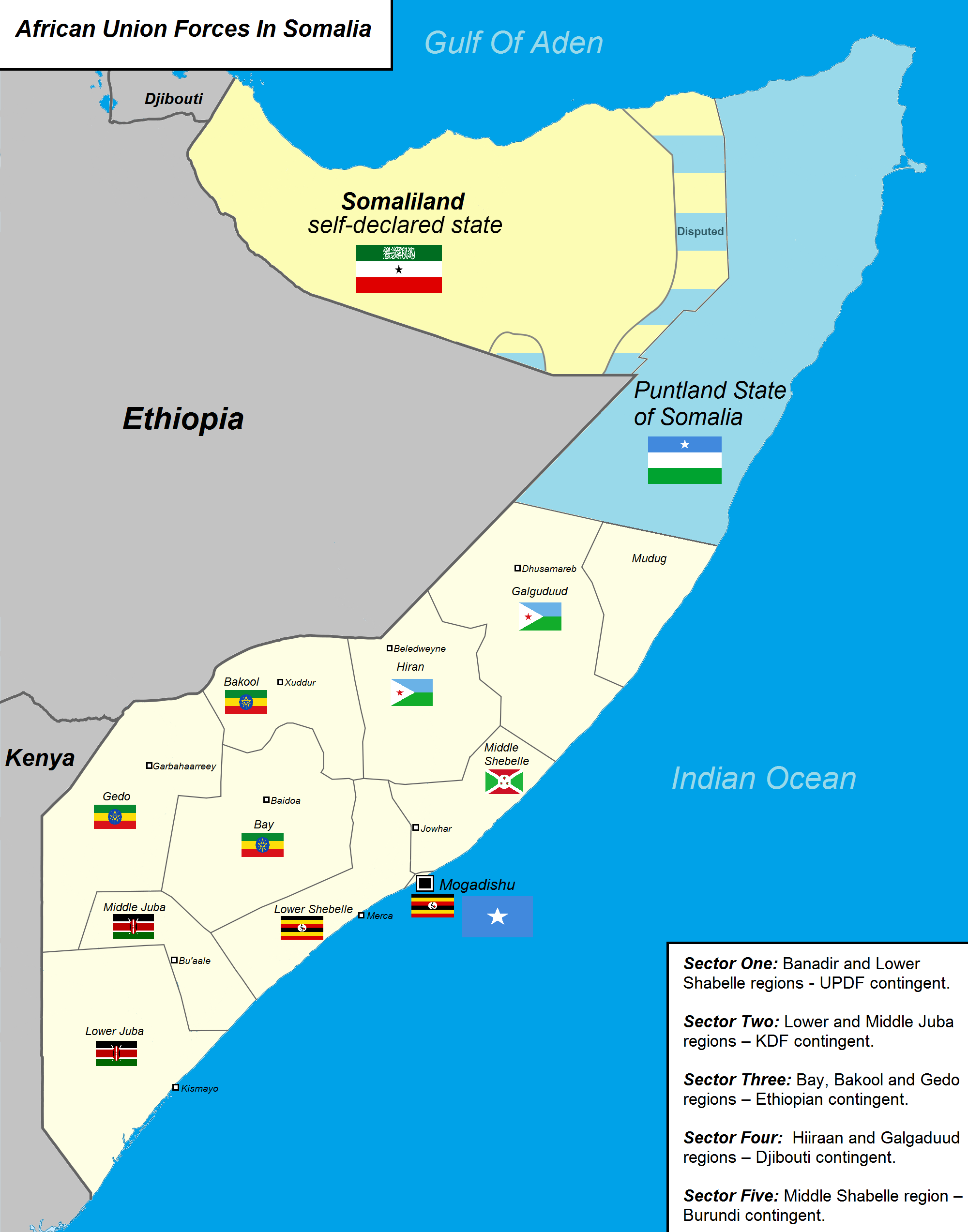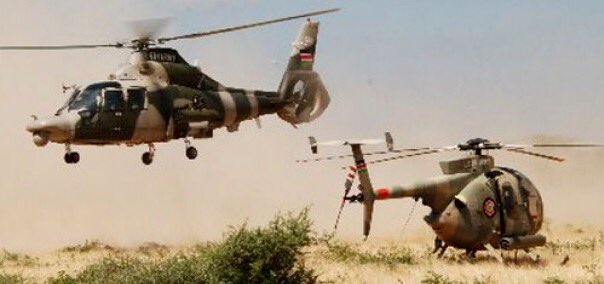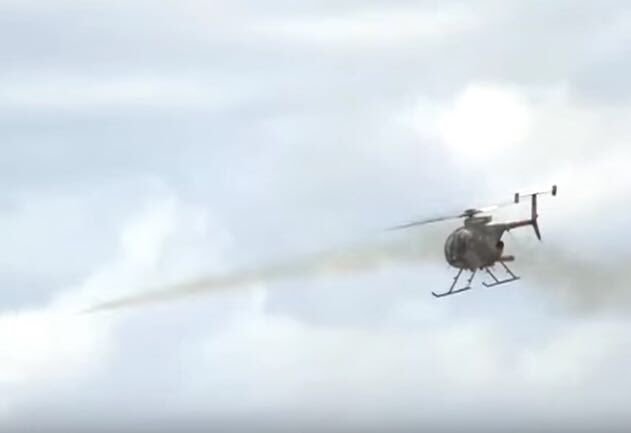It looks like you're using an Ad Blocker.
Please white-list or disable AboveTopSecret.com in your ad-blocking tool.
Thank you.
Some features of ATS will be disabled while you continue to use an ad-blocker.
5
share:

Quick backgroud:
The African Union Mission in Somalia (AMISOM) is an active, regional peacekeeping mission operated by the African Union with the approval of the United Nations in Somalia. It is mandated to support transitional governmental structures, implement a national security plan, train the Somali security forces, and to assist in creating a secure environment for the delivery of humanitarian aid.[1] As part of its duties, AMISOM also supports the Federal Government of Somalia's forces in their battle against Al-Shabaab militants.
On 21 February 2007, the United Nations Security Council authorised the African Union to deploy a peacekeeping mission with a mandate of six months.[3] In March 2007, Ugandan military officials arrived on the ground in Somalia.[14] On 20 August 2007, the United Nations Security Council extended the African Union's authorisation to continue deploying AMISOM for a further six months and requested the Secretary-General to explore the option of replacing AMISOM with a United Nations Peacekeeping Operation to Somalia.[4]
Most recently, on 26 May 2017, the UN Security Council unanimously approved resolution 2355, authorising member States of the African Union to maintain the deployment of the African Union Mission in Somalia (AMISOM) until 31 August 2017 with a maximum strength of 22,126 uniformed personnel.[15]
What happened was the UN had a plan to try and get some muscle behind the Transitional Federal Government (TFG), which had just kind of stayed in limbo for years in the city of Baidoa and had no authority or influence outside of that city. After a popular Islamic movement called the Islamic Courts Union had taken control and established order, civil services, and curbed piracy/crime in 2006 the US and AU made plans to seize on those gains and drive out the ICU. Eventually Ethiopia invaded, followed by tens of thousands of troops from the African Union states of Uganda, Kenya, Burundi, Ethiopia and Djibouti and had all but destroyed the ICU and all the stability they brought.
Unfortunately as a result, the new terrorist group al-Shabab formed to counter what was seen as a foreign invasion by neighboring states supported by American and European interests. Instability and conflict have remained to date.
The question of funding now arises because the EU has been paying monthly stipends for the troop contributing countries' soldiers and recently they have cut the monthly allotment by 20%. The following report is the premise of this thread.
Paying for AMISOM
How a peace operation is financed is always an important issue. But money matters for the African Union Mission in Somalia (AMISOM) have recently become highly politicized. This is in large part because of the complicated set of arrangements and mechanisms that are required to fund AMISOM. Particularly since mid-2015, some of these arrangements have come under pressure to change owing to a variety of factors, including the longevity of the mission, circumstances in the global economy, and other international crises on the African continent and beyond. The changes have had the predictable knock-on effect of causing political arguments between the African Union, the AMISOM troop-contributing countries (TCCs), and some of the mission’s key partners, most notably the European Union.
Paying AMISOM’s monthly allowances has become the EU’s single largest development project in Africa. The EU first started providing financial support to AMISOM in 2007. The monies came from the EU’s African Peace Facility (APF), which is part of the European Development Fund. The APF is the EU’s main source of funding to support the efforts of the AU and the African Regional Economic Communities in the area of peace and security. Since 2004, it has disbursed more than €2 billion.
When the EU first supported AMISOM it was understood, as per the AU’s wishes, that the mission would last six months before transitioning into a UN peacekeeping operation. In 2007, AMISOM had an authorized strength of 8,000 troops but only some 1,600 Ugandan troops actually deployed. The level of EU financial support to AMISOM at this stage therefore amounted to approximately €700,000 per month. By 2016, AMISOM had over 22,000 personnel and the cost to the EU was about €20 million per month. Most of this financial support was spent on troop allowances, but it was also used for other issues including death and disability compensation for AMISOM peacekeepers killed or wounded in action and indirect support costs such as supporting some AU personnel working on peace support operations in Addis Ababa and AMISOM offices in Nairobi and Mogadishu as well as with training.
In total, between 2007 and September 2016, the EU had committed nearly €1.05 billion to financially support AMISOM under the APF. The EU position remains that the AU can decide to pay AMISOM soldiers whatever rate it chooses, but the EU would, from January 2016, pay no more than €738/$822 per peacekeeper per month. The EU hoped that the AU could find another partner to fill the subsequent gap in payments. So far, a way of closing the funding gap has not been found.
To what extent, if any, might the current AMISOM funding crisis alter the strategic partnership between the AU and EU? How can other AU partners close the funding gap at a critical time in the process of stabilizing Somalia? The AU’s efforts to generate financial support for AMISOM from other partners, including China, Turkey, India, Russia, and the Gulf states, has failed to produce significant results. What would a sustainable set of financial arrangements for AMISOM entail? While the recent AU initiatives aimed at financing its own peace and security initiatives by 2020 are a positive step forward, they will not come soon enough to solve the current crisis concerning AMISOM. An alternative approach is needed and will almost certainly involve the UN.
Paul D. Williams is Associate Professor of International Affairs at George Washington University. @PDWilliamsGWU.
How many of our European members even knew that the EU was financing AMISOM?? Visit the linked article for the full report, including how the EU has had to jump through hoops to get money to the Burundi contingent while bypassing their government due to sanctions??
I have been reporting on increased US commitment to SNAF and AMISOM since this year and theorized that we would gradually see more about US involvement there. The Current AU mandate is up in August. It is unknown whether it will be extended another six months. The AU would like to see this mission transfer over to the UN in an effort to settle financing. Either way, in 2018 it is either going to be the UN or the US doing the bulk of financing, and who knows how the troop deployment schedule could change.
Pentagon Deploys 101st Airborne Division to Somalia
American Soldier KIA In Somalia in May 2017
Well, we are knocking on the door of another charlie-foxtrot with this one and tying down the many assets of the RDF is just not a smart move. Has the
MS and MOs been published ?
edit on 25-6-2017 by flatbush71 because: (no reason given)
Wow, you're pretty good at looking around for information about some issues. Seems your interests are in that area of the world right now.
a reply to: rickymouse
My interests are global for some time now. There is quite a trove of the current ops against ISIS in Philippines as well, which is not going well btw. I plan on jumping on that as well. I like to try and make as few threads as possible when the subject is the same, so I am always going back and updating some of the older articles.
and as an FYI, I am finding everything through twitter. I utilize it specifically as an aggregator for international conflict news, and then follow those sources to domestic media of locality in question when possible, or wherever it takes me.
Here check it out, I uploaded this after I found it on twitter. It is a combat air support mission by US forces backing the Somali National Armed Forces. It is from somebody on the ground out there who has been posting regular updates. Although this is publicly available and accessible, I am going to withhold his account information for now just as a precaution. I don't want to flow of information to suddenly stop.
Some other images posted by the same guy.
Chief we operate the Z 9 Helos, under power for this region
Full on Joint Ops SNAF AMISOM
Somalia air ops
FGS we are working together Heavy Ops in support SNAF
Im in the process of doing a specific thread for Somali and Philippines, where I also collect related ATS threads and focus on making those where general updates can be found. Sometimes if the story is enough to carry itself, I will do a separate thread for it. Otherwise I just add it to a relevant one that already exists.
My interests are global for some time now. There is quite a trove of the current ops against ISIS in Philippines as well, which is not going well btw. I plan on jumping on that as well. I like to try and make as few threads as possible when the subject is the same, so I am always going back and updating some of the older articles.
and as an FYI, I am finding everything through twitter. I utilize it specifically as an aggregator for international conflict news, and then follow those sources to domestic media of locality in question when possible, or wherever it takes me.
Here check it out, I uploaded this after I found it on twitter. It is a combat air support mission by US forces backing the Somali National Armed Forces. It is from somebody on the ground out there who has been posting regular updates. Although this is publicly available and accessible, I am going to withhold his account information for now just as a precaution. I don't want to flow of information to suddenly stop.
Some other images posted by the same guy.
Chief we operate the Z 9 Helos, under power for this region

Full on Joint Ops SNAF AMISOM

Somalia air ops

FGS we are working together Heavy Ops in support SNAF

Im in the process of doing a specific thread for Somali and Philippines, where I also collect related ATS threads and focus on making those where general updates can be found. Sometimes if the story is enough to carry itself, I will do a separate thread for it. Otherwise I just add it to a relevant one that already exists.
new topics
-
Liberal Madness and the Constitution of the United States
US Political Madness: 3 hours ago -
New York Governor signs Climate Law that Fines Fossil Fuel Companies
US Political Madness: 10 hours ago
top topics
-
This is why ALL illegals who live in the US must go
Social Issues and Civil Unrest: 17 hours ago, 19 flags -
New York Governor signs Climate Law that Fines Fossil Fuel Companies
US Political Madness: 10 hours ago, 14 flags -
Meta Llama local AI system is scary good
Science & Technology: 15 hours ago, 6 flags -
Liberal Madness and the Constitution of the United States
US Political Madness: 3 hours ago, 2 flags
5
